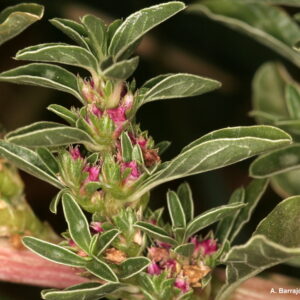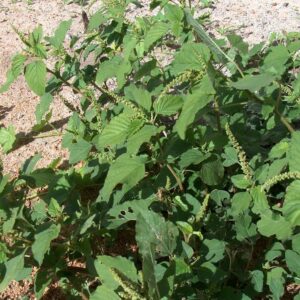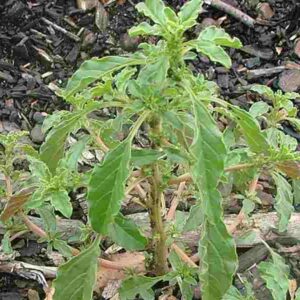| Amaranthus graecizans L., Is an annual herb, and grows primarily in the subtropical biome..
Life Form: Th, Flowering in: Mar-Dec, Vern: —–, Phytochoria: S.Cosm, The native range of this species is Macaronesia, Medit. to Indian Subcontinent and Angola. Notes:– For more information: https://powo.science.kew.org/taxon/urn:lsid:ipni.org:names:10641-2, https://www.itis.gov/servlet/SingleRpt/SingleRpt?search_topic=TSN&search_value=184249#null, https://en.wikipedia.org/wiki/Amaranthus_graecizans, https://uses.plantnet-project.org/en/Amaranthus_graecizans_(PROTA), http://www.efloras.org/florataxon.aspx?flora_id=1&taxon_id=242415677 |
|
Distribution in Libya |
|||||||
| Al-Jafarah Plain | Sirte Plains | Benghazi Plain | Jabal Nafusa area | Al-Jabal Al-Akhder | Marmarica Plateau | Fezzan area | Gebel Uweinat |
| (20 km) E. Tripoli 1966 Tripoli 1975 10 km from Zuara to farwa 1976 Sabratha region 2020 | Sirte 2015, 2016 | Dariana, (40 km) from Benghazi 1972 | Along the coastal road from Tripolito Khoms 1966 | Wadi Zaza 2003 Wadi El-Shees 2014 Sidi Abu-Ras 2017 | From Tobruk to Egyptian Border 1999 | Grega, (150 km) from Sebha to Germa 1973 | Gebel Uweinat 1968 |
| Bibliographic references: | |
| First: Encyclopedia Flora of Libyan: | |
| Jafri, S. M. H. & El-Gadi, A. (1977) Flora of Libya, Amaranthaceae Vol. (42) Department of Botany, Al-Faateh Univ., Tripoli, Libya. | |
| Second: Researches and PhD theses, master theses , Sorted by Newest: | |
| Al-khojah, H.M., Al-Yafour, L.A., Mahklouf, M.H. (2020) Floristic Study of Selected Districts in Sabratha region Libya. J. of Advanced Botany and Zoology Volume 7/Issue 4 ISSN: 2348-7313. https://scienceq.org/floristic-study-of-selected-districts-in-sabratha-region-libya.php | Sabratha region Libya 2020 |
| El-Zerbi, A. K. & Al-Aib, M.A. (2017) Study of vegetation cover in Sidi Bouras region, Al-Jabal Al-Akhdar, Journal of Environmental Science and Engineering JESE, VOL. 1, No. 1, January 2017 (In Arabic) http://jese.uoa.edu.ly/JESE_V1N1/JESE_V1N1P11.pdf | سيدي ابو راس 2017 |
| Elsayed, N. (2016) Relationship between Vegetation and Soil Seed Bank at Protected Versus Unprotected Sites at Coastal Habitats in Libya.CATRINA (2016), 15 (1): 59-68. https://scholar.google.com.eg/citations?user=mSAskW0AAAAJ&hl=en, https://cat.journals.ekb.eg/article_18337_76652686b5c99f5fd479aebab87fbcb4.pdf | Surt region in Libya 2016 |
| Elsayed M. A. N. (2015) Floristic Composition of the Plant Cover at Surt Region in Libya. Catrina (2015), 12 (1): 63-71-2010 By the Egyptian society for environmental SCIENCES. https://cat.journals.ekb.eg/article_18403_37c687e375b9144800a15704e68ebad7.pdf | Plant Cover at Surt Region2015 |
| Shaltout, K. , Fawzy, M., Galal, T., Awad, M. , El-Barasi, Y. (2014) Impact of waste water discharge on the plant communities and size structure of Wadi El-Shees, Al-Jabal Al-Akhdar, Libya. Feddes Repertorium 2014, 125, 1–13, DOI: 10.1002/fedr.201400023, c 2014 WILEY-VCH Verlag GmbH & Co. KGaA, Weinheim. https://onlinelibrary.wiley.com/doi/abs/10.1002/fedr.201400023, https://scholar.google.dk/citations?user=3-C8aFIAAAAJ&hl=ja | |
| El-Barasi, Y. M., EI-Sherif, l. M. & Gawhari, A. M. H.(2003) Checklist and analysis of the flora and vegetation of Wadi Zaza at AI-Jabal AI Akhdar (Cyrenaica, Libya). Bocconea 16 (2): 1091-1105. 2003. – ISSN 1120-4060. http://www.herbmedit.org/bocconea/16-1091.pdf | |
| Al-Habony MEE 1999. Vegetation and flora of a sector along Mediterranean Coast of Libya from Tobruk to Egyptian border. MSc. Thesis. Department of Botany. Faculty of Science. Benghazi University. Benghazi. Libya. |





